With the increasing trend towards smart homes, smart door locks have become a popular feature for homeowners looking to enhance their security.
But how do smart door locks get power they need to operate? In this article, I will take you on a journey to explore the different ways smart door locks get their power, from batteries to wired connections.
You’ll be surprised to learn about the innovative technologies used to power these locks and how they have revolutionized the way we secure our homes.
Let’s take a closer look to uncover the mystery behind electronic door locks‘ power source.
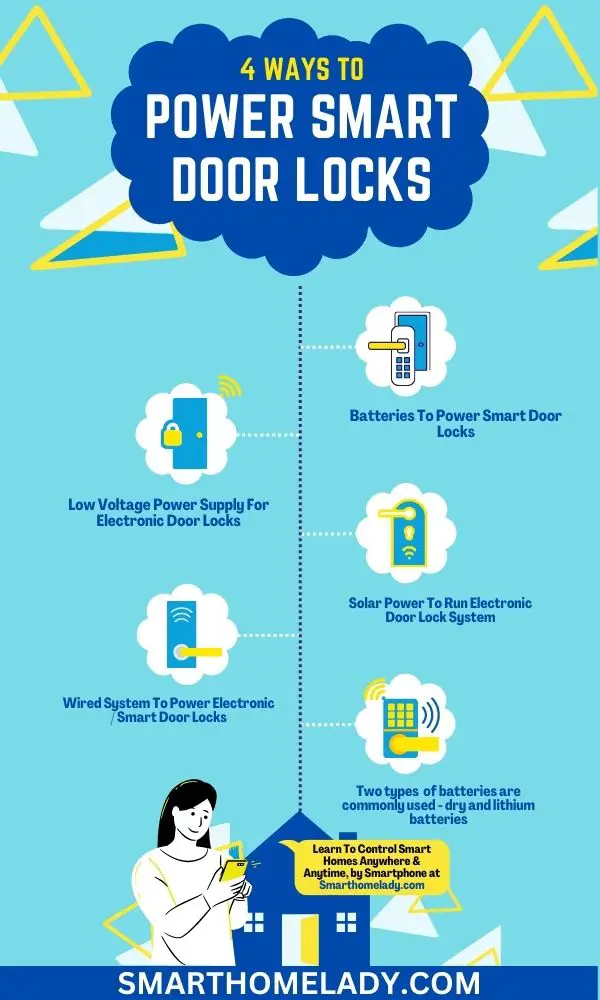
Contents
- 1 4 Ways On How Do Smart door locks get power?
- 2 Does a smart door lock need electricity?
- 3 How are digital door locks powered?
- 4 Are smart door locks battery-powered?
- 5 Do smart locks run out of battery?
- 6 How do smart locks work when power is out?
- 7 How do smart locks charge?
- 8 Are smart locks hard-wired?
- 9 How are Schlage locks powered?
- 10 How is a Yale smart lock powered?
- 11 What happens if a smart lock loses power?
- 12 How do keypad door locks get power?
- 13 Conclusion
4 Ways On How Do Smart door locks get power?
Smart door locks offer convenience and security to homeowners. But how do these high-tech devices get the power they need to function?
There are a few different ways that smart door locks can get power. Some models use batteries, while others are hardwired into the home’s electrical system.
Following are a few options for powering smart door locks.
1. Batteries To Power Smart Door Locks
Batteries are the backbone of smart door locks, providing them with the necessary juice to operate. In fact, they are the most common source of power for these modern security devices.
When it comes to batteries, two types are commonly used – dry and lithium batteries. Let’s explore their differences and how they impact the performance of smart door locks.
Dry Batteries for Smart Door Locks
When it comes to powering your smart door lock, there are different types of dry batteries to consider. It can be categorized into;
- A Single Group Of 4 AA Batteries
- Dual Group Of 4 AA Batteries (Total 8 batteries In 2 Groups)
- A Single Group Of 8 AA Batteries Powered
i. Single Group Of 4 AA Batteries
The single group of 4 AA batteries is the most common type of dry battery used in smart locks. These batteries can last for several months (6 months to 1 year), depending on the usage.
This type of battery is stable and reliable and works for most smart locks. It is easy to replace and widely available in stores.
Comparison Table Of The Three Types Of Dry Batteries For Smart Door Locks
| Battery Type | Number of Batteries | Battery Life | Risk of Leakage | Convenience of Replacement |
|---|---|---|---|---|
| Single Group of 4 AA Batteries | 4 | Several months (6 months – 1 year) | Low | Easy |
| Dual Group of 4 AA Batteries | 8 (in 2 groups) | Up to 20 months | High | Moderate |
| Single Group of 8 AA Batteries | 8 | Longer than 20 months | High | Inconvenient |
ii. Dual Group Of 4 AA Batteries
If you want longer battery life for your smart lock, you can opt for the dual group of 4 AA batteries. This type of battery can support your lock for up to 12-20 months.
However, it comes with the risk of leakage, which can damage your lock. It’s important to regularly check and replace the batteries in your smart lock to avoid any potential damage.
iii. A Single Group Of 8 AA Batteries Powered
The single group of 8 AA batteries is not commonly used among top brands. While it may offer longer battery life, it can be bulky and inconvenient to replace.
This type of battery is not widely available in stores and may be expensive compared to other options. Therefore, it is not a popular choice for smart lock owners.
Lithium Batteries To power Smart Door Locks
Lithium batteries are a more expensive option, but they have a longer lifespan and can provide more power to the smart lock. They are also more reliable and less likely to leak or corrode, which can be a problem with some types of dry batteries.
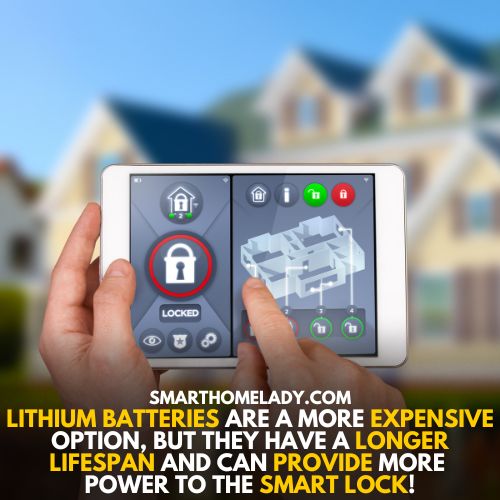
If you have a high-power motor lock, then lithium batteries are recommended for optimal performance.
Lithium batteries are known for their long-lasting power and durability, making them ideal for smart door locks. Look for a battery with a capacity of 3000mAh or more to ensure your lock stays powered for longer.
When using lithium batteries, it’s essential to choose the right type of battery for your smart lock. Some smart locks may require a specific type of lithium battery, so it’s important to check the manufacturer’s instructions before purchasing.
Pro Tip – In case of emergencies, most smart door locks have different unlocking methods. Emergency power is supported through a USB interface and power bank, while the mechanical key is a traditional way of unlocking the door.
Overall, choosing the right type of battery for your smart door lock depends on your specific lock and usage needs. It’s important to regularly check and replace your batteries to ensure optimal performance and avoid any potential damage.
2. Low Voltage Power Supply For Electronic Door Locks
Another popular power source is a low-voltage power supply. Low voltage systems provide the same security as batteries but with less maintenance required. It makes them an ideal choice for homes that need reliable lockout protection and access control.
Many times this type of system will cost less in the long run than battery replacement costs.
A low-voltage power supply uses a step-down transformer to convert 120 volts AC into 12-volt DC electricity.
The output is then fed through a current-limiting device, such as a resistor, before it reaches the door lock’s motor assembly. This ensures that only enough energy is used to operate the lock without overloading the circuit, which could cause permanent damage.
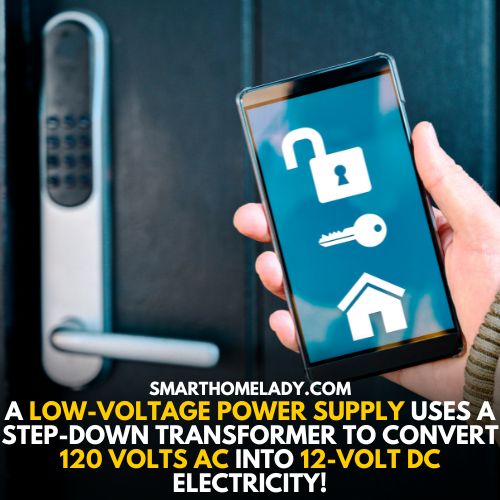
Additionally, if any wiring issue occurs, it won’t disrupt other electrical components since all wiring runs on its line from the transformer box directly to each individual lock mechanism.
The ease of installation combined with reliability make low voltage systems a great go-to choice when it comes to powering your electronic door locks.
3. Solar Power To Run Electronic Door Lock System
No power, no door lock. It’s that simple. And when it comes to powering up electronic door locks, solar energy can be an ideal solution as it is efficient, cost-effective, and environmentally friendly.
The advantages of using solar power are clear. Solar efficiency is high – with the right setup, you can get all the electricity needed for your locking system without needing any additional sources of energy.
There’s a cost-saving too. Photovoltaic cells require little maintenance or upkeep once installed, making them much cheaper than other electrical solutions in the long run.
Furthermore, since most photovoltaic cells have a lifespan of 25 years or more, you won’t need to worry about replacing them soon, either. They’re designed to withstand extreme weather conditions as well as wear and tear over time.
On top of this, having solar panels on your property means fewer greenhouse gases being released into the atmosphere – another environmental benefit.
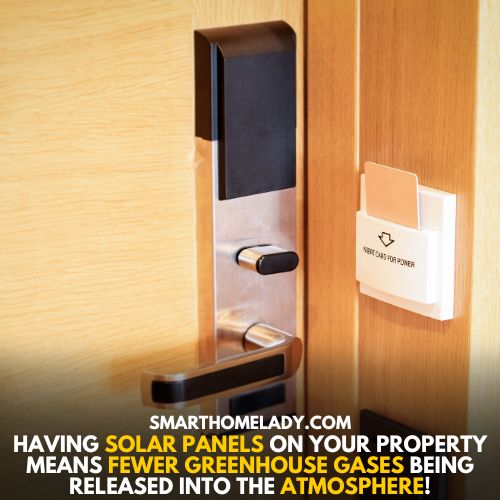
4. Wired System To Power Electronic / Smart Door Locks
Wired power is an option for supplying energy to a lock that relies on either alternating current (AC) or direct current (DC). Such a power source makes use of electricity from the building’s wiring.
It provides reliable access control in locations where there are no windows or doors with natural light exposure. By connecting the lock directly through a connection point, AC/DC adapters provide a steady supply of voltage when necessary.
Because this type of electric current requires physical contact between the adapter and the socket, it limits tampering attempts which increases security levels significantly.
Additionally, because these sockets must be grounded correctly before installing any electric devices, they further ensure safety protocols have been followed properly during installation.
Wired powering solutions are ideal because they do not require extensive maintenance. They offer long-term reliability while providing protection against unauthorized access.
Moreover, they come with a variety of technical features, such as adjustable timing functions allowing users to tailor their access requirements more precisely.
Read More:
- Why Schlage Smart Lock Drain Battery?
- Does Smart Door Locks Drain Battery?
- How Long Do Smart Door Lock Batteries Last?
- Does Schlage Make A Smart Key Lock?
Frequently Asked Questions FAQs
Does a smart door lock need electricity?
A smart door lock does need electricity to function. Most smart locks are battery-powered, but they require electric power to operate.
The batteries power the lock’s electronics, which communicate with your smartphone or other devices. Without electricity, the smart lock won’t work.
How are digital door locks powered?
Digital door locks are powered by batteries. These batteries provide the electricity needed to power the lock’s electronics.
The battery life of a smart lock can vary based on usage and the specific brand and model of the lock.
Some smart locks have batteries that can last up to a year, while others may require more frequent battery changes.
Are smart door locks battery-powered?
Yes, smart locks are battery-powered. The batteries power the lock’s electronics, which allows you to control the lock using your smartphone or other devices.
The battery life of a smart lock can vary based on usage and the specific brand and model of the lock.
Some smart locks have batteries that can last up to a year, while others may require more frequent battery changes.
Do smart locks run out of battery?
Yes, smart locks can run out of battery if the batteries are not replaced in time. When the battery dies, the lock will stop working until new batteries are installed.
Some smart locks have low battery indicators to alert you when the battery is running low.
How do smart locks work when power is out?
When the power is out, most smart locks will still work. Many smart locks have battery backup systems that will keep the lock operational even if the power goes out.
However, if the batteries are dead, the smart lock will not work.
How do smart locks charge?
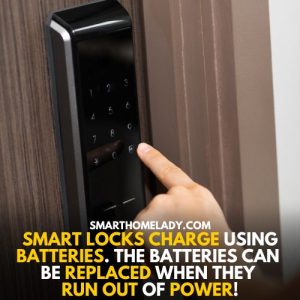
Smart locks charge using batteries. The batteries can be replaced when they run out of power. Some smart locks have rechargeable batteries that can be charged using a USB cable.
Most smart locks use standard alkaline batteries, such as AA or AAA batteries, which are widely available and easy to replace.
Some smart locks also have rechargeable batteries that can be charged using a USB cable.
These types of locks are convenient because they eliminate the need to replace batteries, which can be costly and time-consuming.
Are smart locks hard-wired?
Yes, some smart locks can be hard-wired for power. Hard-wiring a smart lock allows the lock to be powered by your home’s electrical system rather than relying on batteries.
This can be a convenient option for those who don’t want to worry about changing batteries or running out of power.
However, it’s important to note that hard-wiring a lock requires electrical knowledge and expertise. If you’re not comfortable with electrical work, it’s best to hire a professional to install the lock for you.
How are Schlage locks powered?
Schlage locks are powered by batteries. The batteries power the lock’s electronics, which allows you to control the lock using your smartphone or other devices.
The battery life of a smart lock can vary based on usage and the specific brand and model of the lock.
Some smart locks have batteries that can last up to a year, while others may require more frequent battery changes.
How is a Yale smart lock powered?
Yale smart locks are powered by batteries. The batteries provide the electricity needed to power the lock’s electronics, which allows you to control the lock using your smartphone or other devices.
What happens if a smart lock loses power?
If a smart lock loses power, it may not work until power is restored. However, many smart locks have battery backup systems that will keep the lock operational even if the power goes out.
How do keypad door locks get power?
Keypad door locks get power from standalone batteries. These batteries provide the electricity needed to power the lock’s electronics, which allows you to control the lock using a keypad or other devices.
The battery life of a keypad lock can vary based on usage and the specific brand and model of the lock. Some keypad locks have batteries that can last up to a year, while others may require more frequent battery changes.
Conclusion
In conclusion, smart door locks are powered by a variety of sources, including batteries, wired connections, and even solar panels.
Regardless of the power source, it’s important to choose a smart lock that offers a reliable and long-lasting power supply. By doing so, you can enjoy the convenience and security of a smart lock without worrying about it running out of power at a crucial moment.
If you’re in the market for a smart lock, be sure to do your research and choose one that fits your needs and preferences.
And if you already have a smart lock, take the time to ensure that its power source is working properly to keep your home safe and secure.


